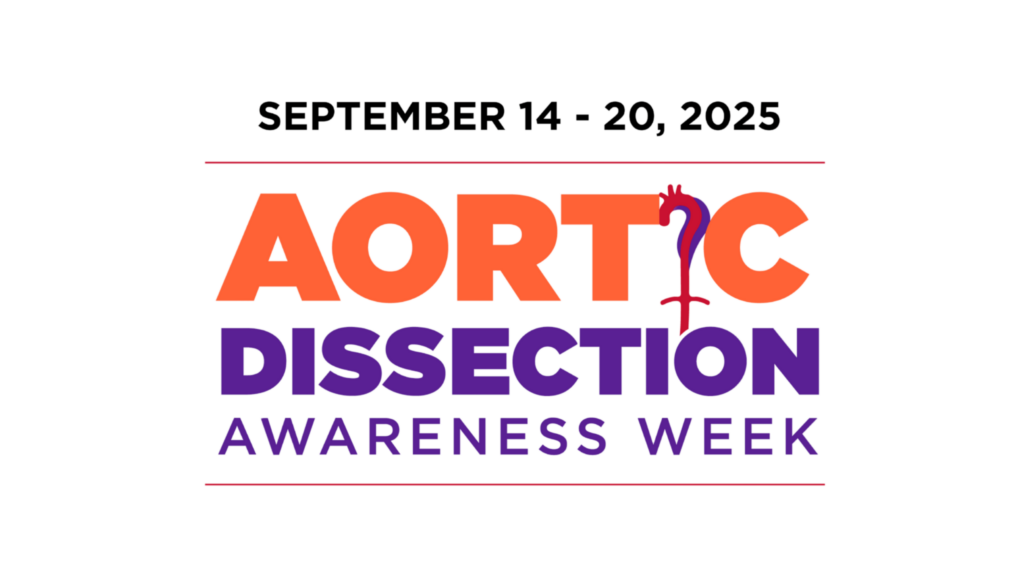

Note: If you are currently experiencing an emergency or crisis, contact your doctor, call 911, or go to the nearest emergency room.
Aortic Dissection Awareness Week is a time when we especially focus on helping everyone understand the genetic risk factors for aortic dissection, the signs and symptoms of aortic emergency, how to prepare for an emergency, and how to best reduce risk.
The Marfan Foundation serves people living with genetic aortic and vascular complications due to conditions like Marfan, Loeys-Dietz, VEDS, and related conditions. These individuals have an estimated 250x increased risk of aortic dissection. That’s why this week matters.
What Everyone Should Know About Aortic Dissection
-
What is aortic dissection?
Aortic dissection is a tear or rupture between layers of the aortic wall that can be fatal and is always serious.
-
Who is at risk?
People with connective tissue conditions affecting the aorta, like Marfan, LDS or VEDS. People with high blood pressure, high cholesterol or atherosclerosis, smokers, or individuals older than 65. Additionally, people with a family history of aneurysm or dissection.
-
Does it run in the family?
About 20–25% of people with thoracic aortic aneurysm or dissection have a heritable cause or family history; first-degree relatives should be screened and assessed for risk.
-
Symptoms of aortic dissection
Everyone should know the signs and symptoms of aortic dissection, and seek emergency medical help for themselves or loved ones immediately if they occur.
Symptoms of aortic dissection usually appear suddenly and may include:
• Severe, sudden, constant chest pain and/or upper back pain, sometimes described as “ripping” or “tearing.”
• Pain that feels like it is moving from one place to another
• Unusually pale skin
• Faint pulse
• Numbness or tingling
• Paralysis
• In some instances, there may be no pain but a sense that there is something terribly “wrong.” -
Symptoms of aortic aneurysm
Symptoms are rare; however, some people may experience symptoms where an aneurysm is growing. For example, shortness of breath, difficulty swallowing, swelling of arms, neck, or face, or pain in the neck, back, chest or abdomen.
-
Stay ahead of aortic risk
People who are aware that they are at increased risk can help mitigate their risk for experiencing aortic dissection by working closely with their healthcare providers which may include a medical geneticist, cardiologist, and cardiovascular surgeon.
Learn how to find your healthcare team here.
Find us on Social
How Can I Help?
-
Spread the Word
• Visit our official social media accounts, like and share our message.
• Download our ADAW art and post to your social media throughout the week.
-
Learn More
Use the resources on this page to better understand aortic emergencies, prevention, and risk. Know the signs and symptoms.
-
Donate Today
Your contribution saves lives! Donate TODAY to advance education, prevention, and treatment of genetic aortic conditions.

Know the Signs, Save a Life
Aortic dissection is a medical emergency that requires immediate attention. Our visual guide highlights the critical symptoms to watch for.
Act Fast: If you or someone you know experiences these symptoms, seek emergency medical help immediately. Early recognition and treatment can be life-saving.
Stay Informed: Share this image to raise awareness and help others recognize the signs of aortic dissection. Your knowledge could make a crucial difference in someone’s life!
Be Aware. Be Prepared. Act Quickly.
Prepare for Emergencies
If you are at increased risk, know how to advocate for yourself during an emergency. We have tools to help!

In this two-minute video, Dr. Kim Eagle talks about the three things he wishes every emergency department caregiver knew about aortic emergencies.
Please share with the healthcare providers in your life!
Life-Saving Resources
Dr. Juan Bowen on Aortic Anatomy & Aortic Aneurysms
Emergency Preparedness & Coping with Crisis
Advocating for Yourself & Others
Understanding & Managing the Impact of Medical Trauma
From our Friends at Think Aorta
From our Friends at Aortic Hope
For Healthcare Professionals
Diagnosis and Treatment of Aortic Dissection in the ER – Part 1
Diagnosis and Treatment of Aortic Dissection in the ER – Part 2
Surgery for Sporadic Aortic Aneurysms of the Aortic Root and Ascending Aorta
Surgical Thresholds for Root and Ascending Aortic Replacement in Loeys- Dietz Syndrome
Phenotypic Features that may Suggest an Underlying Syndromic HTAD
3 Things ED Pros Need to Know About Aortic Emergencies
ACC Aortic Disease Guidelines: Pregnancy
Genetic Testing for Aortopathy
AHA/ACC Aortic Guidelines: Delivery
From our Friends at Think Aorta
From our Friends at Aorta Hub
From Our Friends at the John Ritter Foundation
Note: If you are currently experiencing an emergency or crisis, contact your doctor, call 911, or go to the nearest emergency room.
